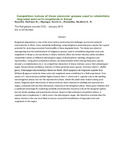| dc.contributor.author | Nyariki, Dickson M. | |
| dc.contributor.author | Mganga, K. Z. | |
| dc.contributor.author | Musimba, N. K. R. | |
| dc.date.accessioned | 2017-02-25T06:33:43Z | |
| dc.date.available | 2017-02-25T06:33:43Z | |
| dc.date.issued | 2015 | |
| dc.identifier.uri | http://hdl.handle.net/123456789/181 | |
| dc.identifier.uri | https://www.researchgate.net/publication/282772150_Competition_indices_of_three_perennial_grasses_used_to_rehabilitate_degraded_semi-arid_rangelands_in_Kenya | |
| dc.identifier.uri | https://www.publish.csiro.au/RJ/RJ15023 | |
| dc.identifier.uri | https://doi.org/10.1071/RJ15023 | |
| dc.description.abstract | Rangeland degradation is one of the most serious environmental challenges in arid and semiarid environments in Africa. Grass reseeding technology, using indigenous perennial grass species has a great potential for restoring ecosystem functionality in these degraded lands. This study was aimed at investigating how the establishment of indigenous grasses used to rehabilitate degraded semi-arid rangelands in Kenya as monocultures or binary mixtures affect dry matter biomass yields and plant competition indices at different phenological stages of development: seedling, elongation and reproduction. Using plant competition indices, we demonstrated which among these grass species showed a complementary vis-à- vis competitive interaction in binary mixtures across their phenological stages. Monocultures and binary mixtures of three perennial grass species: Cenchrus ciliaris L. (Buffel grass), Enteropogon macrostachyus Munro ex Benth. (Bush ryegrass) and Eragrostis superba Peyr. (Wilman lovegrass) native to these semi-arid rangelands were established in a field experiment. Pure stands of E. macrostachyus yielded higher biomass than C. ciliaris and E. superba only at the seedling and elongation phases but not the reproduction phase, where the yields were lowest among pure stands. Negative plant interactions in binary mixtures were observed at seedling and reproduction stages, compared with positive interactions observed at the elongation phase. Binary grass mixtures had a significant advantage for exploiting available environmental resources only at the elongation phase but not at the seedling and reproduction phases. Based on the estimated competition indices, E. superba best complements C. ciliaris across the phenological stages. We therefore conclude that this binary mixture is the one most likely to ensure successful rehabilitation of degraded semi-arid rangelands in this region. | en_US |
| dc.language.iso | en | en_US |
| dc.subject | range management | en_US |
| dc.title | Competition indices of three perennial grasses used to rehabilitate degraded semi-arid rangelands in Kenya | en_US |
| dc.type | Article | en_US |

